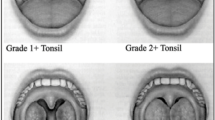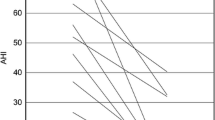Abstract
To compare the nocturnal oxygen saturation profiles of children with adenotonsillar enlargement with that of normal children. A 1 year comparative study. The study was carried out at the Otorhinolaryngology Ward of the University College Hospital Ibadan. These comprise of 60 children (1–9 years) with clinically confirmed adenotonsillar enlargement admitted for adenotonsillectomy and 60 normal children matched for age and sex. The biodata and common clinical presentations of the study group were acquired with a structured proforma. The severity of nasopharyngeal obstruction was determined by the adenoidal–nasopharyngeal ratio while the degree of tonsillar enlargement was graded by the Brodsky’s classification. The nocturnal oxygen saturation of all the participants were recorded with a wrist worn pulse oximeter. Recording was for at least for 4 h. Oxygen saturation <92 % was regarded as desaturation. The oximetric values of the study and control group were compared. The mean nocturnal SPO2 (peripheral saturation of oxygen) profiles of children with adenotonsillar enlargement were as follows: basal = 96.86 %, minimum = 84.99 %; maximum = 99 % and average SPO2 <92 % = 87.74 % while the saturation profiles of the control group were as follows; basal = 97.88 %, minimum = 89.71 %; maximum = 99 %, average SPO2 <92 % = 90.82 %. Normal children have better nocturnal saturation profiles than children with adenotonsillar enlargement.
Similar content being viewed by others
References
Arita M, Kodama S, Suzuki M, Mogi G (2003) Single cell analysis of adenoid CD5+B cells and their protective contributions to nasopharyngeal immunity. Laryngoscope 113(3):484–491
Ganong WF (2003) Regulation of respiration. In: Ganong WF (ed) Review of Medical Physiology, 19th edn. McGraw-Hill Professional, Lange Medical Books, New York, p 640
Bailey MC, Croft BC (1997) Sleep apnoea. In: Adams DA, Cinnamond MJ (eds) Scott Brown’s paediatric otolaryngology. Butterworth-Heinemann, Oxford, p 6/20/1
Huang SW, Giannon C (2001) The risk of adenoid hypertrophy in children with allergic rhinitis. Ann Allergy Asthma Immunol 87(4):2001
Anuntaseree W, Rookkapan K, Kuasirikul S (2001) Snoring and obstructive sleep apnoea in Thai school-children: prevalence and predisposing factors. Pediatr Pulmnol 32(3):222–227
Fujioka M, Young LW, Giardany BR (1979) Radiographic evaluation of adenoidal size in children: ratio. Am J Roentgenol 133:401–404
Scholle S, Rieger B, Kemper G, Seidler E, Glaser S, Zwacka G (2000) Characteristics of sleep-related obstructive respiratory disturbances in childhood. Sleep Breath 04(1):15–20
Loughlin GM, Brouillette RT, Brooks LJ (1996) American Thoracic Society. Standards and indications for cardiopulmonary sleep studies in children. Am J Respir Crit Care Med 153(9):866–878
Waters KA, Cheng AT (2009) Adenotonsillectomy in the context of obstructive sleep apnoea. Pediatr Respir Rev 10(1):25–31
Brouillette RT, Morielli A, Leimanis A, Waters KA, Luciano R, Ducharme FM (2000) Nocturnal pulse oximetry as an abbreviated testing modality for pediatric obstructive sleep apnea. Pediatrics 105(2):405–412
Netzer N (2001) Overnight pulse oximetry for sleep-disordered breathing in adults: a review. Chest 120(2):625–633
Carroll JL, McColley SA, Marcus CL, Curtis S, Loughlin GM (1995) Inability of clinical history to distinguish primary snoring from obstructive sleep apnea syndrome in children. Chest 108(3):610–618
Uliel S, Tauman R, Greenfeld M, Yakov S (2012) Normal polysomnographic respiratory values in children and adolescents. Chest 125:872–878
Marcus CL, Omlin KJ, Basinki DJ (1992) Normal polysomnographic values for children and adolescents. Am Rev Respir Dis 146(5 Pt 1):1235–1239
Brodsky L, Adler E, Stanievich JF (1989) Naso- and oropharyngeal dimensions in children with obstructive sleep apnea. Int J Pediatr Otorhinolaryngol 17(1):1–11
Arrarte J, Lubianca Neto JF, Fischer GB (2007) The effect of adenotonsillectomy on oxygen saturation in children with sleep breathing disorders. Int J Pediatr Otorhinolaryngol 71(6):973–978
Kargoshaie A, Akhlaghi M, Najafi M (2009) Oxygen saturation improvement after adenotonsillectomy in children. Pak J Biol Sci 12(3):276–280
Guilleminault C, Huang Y, Glamann C, Li K, Chan A (2007) Adenotonsillectomy and obstructive sleep apnea in children: a prospective survey. Otolaryngol Head Neck Surg 136(2):169–175
Afolabi OA, Alabi BS, Ologe FE, Dunmade AD, Segun-Busari S (2009) Parental satisfaction with post-adenotonsillectomy in the developing world. Int J Pediatr Otorhinolaryngol 73(11):1516–1519
Fasunla AJ, Onakoya PA, Ogunkunle OO, Mbam TT, Nwaorgu OGB (2011) Routine electrocardiography request in adenoidectomy: is it necessary? Indian J Otolaryngol Head Neck Surg 63(4):330–335
Marcus CL (1997) Clinical and pathophysiological aspects of obstructive sleep apnoea in children. Pediatr Pulmonol 16:123S–124S
Carroll JL, Loughlin GM (1992) Diagnostic criteria for obstructive sleep apnea syndrome in children. Pediatr Pulmonol 14(2):71–74
Messner H, Pelayo R (2000) Pediatric sleep-related breathing disorders. Am J Otolaryngol 2(2):98–107
Arens R, McDonough JM, Costarino AT (2001) Magnetic resonance imaging of the upper airway structure of children with obstructive sleep apnoea. Am J Respir Crit Care 164(4):698–763
Ramos TR, Da Cunba Daltro CH, Gregorio BP, De Freltas Souza SL, De Andrade AN, De Souza Andrade Filbo A et al (2006) OSAS in children: clinical and polysomnographic respiratory profile. Rev Bras Otorhinolaringol 72(3):355–361
Conflict of interest
There is no conflict of interest.
Author information
Authors and Affiliations
Corresponding author
Rights and permissions
About this article
Cite this article
Mbam, T.T., Adeosun, A.A., Akinyemi, O.A. et al. Comparing Oxygen Saturation of Normal Children with that of Children with Adenotonsillar Hypertrophy. Indian J Otolaryngol Head Neck Surg 66, 173–177 (2014). https://doi.org/10.1007/s12070-014-0701-y
Received:
Accepted:
Published:
Issue Date:
DOI: https://doi.org/10.1007/s12070-014-0701-y




